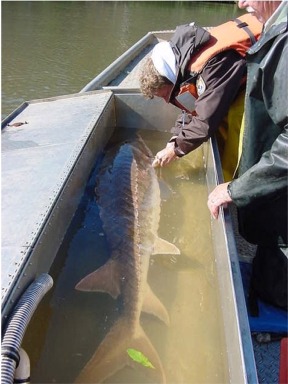- Gulf sturgeon
Taxobox
name = Gulf sturgeon
status = VU
status_ref = Parauka, F.M. 2005. "Acipenser oxyrinchus" ssp. "desotoi". In: IUCN 2006. "2006 IUCN Red List of Threatened Species". [http://www.iucnredlist.org/search/details.php/242/summ] . Accessed on 30 August 2007.]

image_caption = Gulf sturgeon on side
image_width = 225px
regnum =Animal ia
phylum = Chordata
classis =Actinopterygii
ordo =Acipenseriformes
familia =Acipenseridae
genus = "Acipenser "
species = "A. oxyrhynchus" (originally "A. sturio")
subspecies = "A. o. desotoi"
trinomial = "Acipenser oxyrhynchus desotoi"
trinomial_authority = Vladykov, 1955cite journal | last = Ong | first = Tun-Liang | coauthors = Joseph Stabile, Isaac Wirgin, John R. Waldman | title = Genetic Divergence between Acipenser oxyrinchus oxyrinchus and A. o. desotoi as Assessed by Mitochondrial DNA Sequencing Analysis | journal = Copeia | volume = 1996 | issue = 2 | pages = 464–469 | date = 1996-05-16 | url = http://links.jstor.org/sici?sici=0045-8511(19960516)3:1996:2%3C464:GDBAOO%3E2.0.CO;2-M | doi = 10.2307/1446867 | accessdate = 2007-08-30]The gulf sturgeon, "Acipenser oxyrinchus desotoi" is a
subspecies ofsturgeon that lives in theGulf of Mexico and some rivers draining into it. The gulf sturgeon was first recognized as a separate subspecies in 1955. The nominate subspecies is theAtlantic sturgeon , "Acipenser oxyrhynchus oxyrinchus".cite web | last = Fish and Wildlife Research Institute | title = Facts About Gulf Sturgeon | publisher = Florida Fish and Wildlife Conservation Commission | url = http://www.floridamarine.org/features/view_article.asp?id=3346 | accessdate = 2007-08-31] The gulf sturgeon is listed as threatened under the United StatesEndangered Species Act , having been listed in 1991. Critical habitat, reflecting the current range of the subspecies, has been designated (see map). The historical range is thought to have been from theSuwanee River on the western coast of Florida (which contains the most viable sub-population and supplied the only historically sustained commercial fishery) to theMississippi River , and marine waters of the central and eastern portions of the Gulf of Mexico. Three sturgeon species in genusScaphirhynchus share river territory with the gulf sturgeon; none of these areanadromous .U.S. Fish and Wildlife Service and Gulf States Marine Fisheries Commission. 1995. "Gulf Sturgeon Recovery Plan". Atlanta, Georgia.]Physical appearance
Visually, gulf sturgeon are almost impossible to differentiate from Atlantic sturgeon, as the most significant morphological difference is the
spleen length, which is internal. Gulf sturgeon have a spleen length averaging 12.3% of their fork length, while Atlantic sturgeon have a spleen length averaging 5.7% of their fork length. Lesser morphological differences include relative head length, shape of dorsalscute s, and pectoral fin length. Genetic differences between the subspecies have been studied, and tend to indicate that reproductive isolation occurred in thePleistocene period. Behavioral differences are more clear, especially the dietary habits. Adult gulf sturgeon eat primarily, or possibly only, during the winter months when they are in marine or brackish water, and eat little to nothing during the remainder of the year when they are in rivers. Their weights vary in accordance with this eating pattern, with significant weight gains in the winter and smaller weight losses in the summers. Their diet consists of bottom-dwelling organisms including mollusks,grass shrimp , marine worms, isopods and amphipods. The reason for this seasonal eating pattern is unknown.Life cycle
Juvenile gulf sturgeon remain in the spawning river until roughly two years of age, eating there. Thereafter, they join the adults in their anadromous migrations and eating habits. The upriver migration normally occurs between February and April, as river temperatures rise to between 16 and 23 degrees
Celsius . Downriver migration normally begins in late September or October when water temperatures drop to 23 degrees Celsius. Males reach sexual maturity between seven and twelve years of age, females between eight and seventeen years of age. Spawning almost always occurs in the natal river, generally over a hard bottom just downstream of a spring on the river bottom feedinggroundwater into the river. After spawning, the adults and older juveniles collect in regions of cooler, deeper, slower flowing water, generally downstream of springs. cite news | last = Lovgren | first = Stefan | title = Mystery of Florida's Giant Jumping Sturgeon Solved? | work = National Geographic News | publisher =National Geographic Society | date = 2006-10-30 | url = http://news.nationalgeographic.com/news/2006/10/061030-sturgeon.html | accessdate = 2007-08-30 ]Jumping
All species of sturgeon will jump at times. The gulf sturgeon does at two times; in the rivers during July and August and early in the offshore feeding period. It is conjectured that they jump in order to communicate and maintain group cohesion. Since at least 2002, boaters on the Suwannee River have accidentally run into jumping sturgeon every summer, leading to serious injuries.cite news | last = Mayell | first = Hillary | title = Florida Sturgeon "Attacks" Over For Now | work = National Geographic News | publisher =
National Geographic Society | date = 2002-11-12 | url = http://news.nationalgeographic.com/news/2002/11/1112_021112_Sturgeon.html | accessdate = 2007-08-30 ] cite news | last = Kofman | first = Jeffrey | title = The Boater Versus the Beast | work = Nightline | publisher =ABC News | date = 2007-07-13 | url = http://abcnews.go.com/Nightline/Story?id=3375111&page=1 | accessdate = 2007-08-30 ]Population controls
Predators of the sturgeon, other than humans, are unknown but thought to have limited impact upon the species. Parasites include the fish lice "
Argulus stizostehi ",nematode s,trematode s, andleeches . No detrimental impacts from these parasites have been observed. The species also serves as host to the glochidia (larva) of three freshwatermussel species. Overfishing and dam construction probably contributed to the historical decline in populations.ee also
*
Sturgeon
*Atlantic sturgeon , "Acipenser oxyrhynchus oxyrinchus", the other subspeciesReferences
Wikimedia Foundation. 2010.
